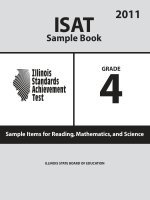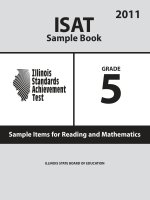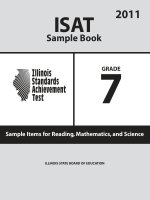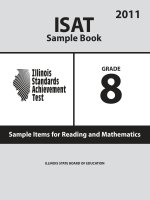ISAT Sample Book 4: Sample Items for Reading, Mathematics, and Science 2009 pot
Bạn đang xem bản rút gọn của tài liệu. Xem và tải ngay bản đầy đủ của tài liệu tại đây (5.66 MB, 112 trang )
GRADE
4
ILLINOIS STATE BOARD OF EDUCATION
2009
ISAT
Sample Book
999-8738-90-3
Sample Items for Reading, Mathematics, and Science
ACKNOWLEDGMENTS
“The Magic Carousel” by Ann Behan, from the August 1997
issue of Highlights for Children magazine. Copyright © 1997
by Highlights for Children, Inc. Columbus, Ohio and used by
permission. Photograph of Snapples by Ken James and used
by permission of A Carousel for Missoula, www.carrousel.com.
CHILDREN ON A MERRY-GO-ROUND: © Richard T. Nowitz/
CORBIS
“Tracking the Elephants”, text and photographs by George
W. Frame, from the February 1998 issue of Highlights for
Children magazine, copyright © 1998 by Highlights for
Children, Inc., Columbus, Ohio and used by permission.
Copyright © 2009 by NCS Pearson, Inc. Copyright © 2009 by the Illinois State Board of Education. All rights
reserved. No part of this publication may be reproduced or transmitted in any form or by any means, electronic or
mechanical, including photocopy, recording, or any information storage and retrieval system, without permission in
writing from the copyright owner. Pearson and the Pearson logo are trademarks, in the U.S. and/or other countries, of
Pearson Education, Inc. or its affi liate(s). Portions of this work were previously published. Printed in the United States
of America.
Printed by the authority of the State of Illinois, 20000, IL00002884.
2009 ISAT Grade 4 Sample Book
3
IL09-I1-4SB
Table of Contents
Introduction 5
READING
Structure of the Grade 4 Reading ISAT 9
Item Formats 9
Reading Sessions 9
Shorter Passage Followed by Multiple-Choice Sample Items 11
Answer Key with Assessment Objectives Identified 14
Longer Passage Followed by Multiple-Choice Sample Items 15
Answer Key with Assessment Objectives Identified 21
Longer Passage Followed by Extended-Response Sample Item 23
Extended-Response Scoring Rubric 29
Annotated Extended-Response Student Samples 32
MATHEMATICS
Structure of the Grade 4 Mathematics ISAT 42
Item Formats 42
Answer Document for Grade 4 Mathematics ISAT 42
Mathematics Sessions 43
Calculator Use for Grade 4 Mathematics ISAT 43
Rulers for Grade 4 Mathematics ISAT 43
Scratch Paper for Grade 4 Mathematics ISAT 43
Multiple-Choice Sample Items 44
Answer Key with Assessment Objectives Identified 56
Short-Response Scoring Rubric 60
Using Short-Response Samples 60
Blank Short-Response Template 61
Short-Response Sample Items and Annotated Student Samples 62
Extended-Response Scoring Rubric 72
Using Extended-Response Samples 73
2009 ISAT Grade 4 Sample Book
4
IL09-I1-4SB
Blank Extended-Response Template 74
Extended-Response Sample Items and Annotated Student Samples 77
SCIENCE
Structure of the Grade 4 Science ISAT 89
Item Format 89
Science Sessions 89
Cumulative Knowledge 89
Multiple-Choice Sample Items 90
Answer Key with Assessment Objectives Identified 106
2009 ISAT Grade 4 Sample Book
5
IL09-I1-4SB
Introduction
is sample book contains sample ISAT items classifi ed with an assessment objective from the Illinois
Assessment Frameworks. ese samples are meant to give educators and students a general sense of how items
are formatted for ISAT. All 2009 ISATs will be printed in color. is sample book does not cover the entire
content of what may be assessed. Please refer to the Illinois Assessment Frameworks for complete descriptions
of the content to be assessed at each grade level and subject area. e Illinois Assessment Frameworks are
available online at www.isbe.net/assessment/IAFindex.htm. e Student Assessment website contains
additional information about state testing (www.isbe.net/assessment).
6
IL09-I1-4SB
7
IL09-I1-4SB
Illinois Standards Achievement Test
Reading Samples
8
IL09-I1-4SB
2009 ISAT Grade 4 Sample Book
9
IL09-I1-4SB
Structure of the Grade 4 Reading ISAT
ISAT Reading testing in spring 2009 will consist of 30 norm-referenced items, as well as criterion-referenced
items. e 30 norm-referenced items are an abbreviated form of the Stanford 10 Reading assessment,
developed by Pearson, Inc. e criterion-referenced items are all written by Illinois educators and pilot tested
with Illinois students.
Item Formats
All items are aligned to the Illinois Reading Assessment Framework, which defi nes the elements of the Illinois
Learning Standards that are suitable for state testing.
Multiple-choice items require students to read and refl ect, and then to select the alternative that best
expresses what they believe the answer to be. A carefully constructed multiple-choice item can assess any of
the levels of complexity, from simple procedures to sophisticated concepts.
Extended-response items require students to demonstrate an understanding of a passage by explaining key
ideas using textual evidence and by using this information to draw conclusions or make connections to other
situations. e extended-response items are scored with a holistic rubric and count as 10% of the scale score
of the test.
Reading Sessions
All standard time administration test sessions are a minimum of 45 minutes in length. Any student who
is still actively engaged in testing when the 45 minutes have elapsed will be allowed up to an additional 10
minutes to complete that test session. More details about how to administer this extra time will appear in the
ISAT Test Administration Manual. is policy does not aff ect students who already receive extended time as
determined by their IEP.
Reading ISAT Grade 4
Session 1
45 minutes
6 shorter passages—30 multiple-choice items total
Session 2
45 minutes
Two longer passages consisting of:
1 expository passage with 10 multiple-choice items
1 literary passage with 10 multiple-choice items
1 extended-response item
Session 3
45 minutes
Two longer passages consisting of:
1 expository passage (or paired passage) with 10 multiple-choice items
1 literary passage (or paired passage) with 10 multiple-choice items
1 extended-response item
(Some items will be pilot items.)
10
IL09-I1-4SB
Shorter Passage Followed by
Multiple-Choice Sample Items
11
IL09-I1-4SB
12
IL09-I1-4SB
GO ON
Reading
XEF244 Passage XEF244.AR1
Summer Palace
by
Heidi Chang
“Here, Yeh Yeh (grandfather), I drew
another picture for you.”
“Ah, Sasha, you are getting so good
now,” her grandfather said. Sasha liked
to draw so much. She could spend hours
at the kitchen table drawing. Sasha
especially liked giving her drawings to
her grandfather.
Yeh Yeh hung all of Sasha’s pictures
in his study. It made Sasha feel special.
Her grandfather always found a place for
them.
“What is this drawing, Sasha?” her
yeh yeh asked, putting on his glasses
and looking closely. Sasha liked the way
her grandfather took time to talk about
her drawings.
“Well, that’s Dad coming home from
work and taking off his shoes,” Sasha
said.
“It’s very nice. I think I’ll put it here
right next to my books.” Sasha’s
grandfather had been a scholar in China
and had a lot of books. Many of them
were old and taped together. She knew
the story of when Yeh Yeh left China.
All he packed in his two suitcases were
books. Sasha knew how much Yeh Yeh’s
books meant to him. She was proud to
have her drawings hang above them.
“I’m glad you always like my
drawings, Yeh Yeh,” Sasha said.
“Your drawings are very special to me,
Sasha,” he said. “Do you know why?”
“Well, probably because I’m your
granddaughter,” she laughed.
“Yes, I suppose,” her grandfather
said, removing his glasses. He patted
Sasha on the head. “I never told you this
before because I thought you were too
young to understand. But your drawings
remind me of my father.”
“They do? Why?” she asked.
“Well, he was an artist. He came to
Beijing from a small village in China. He
was a young man at the time when they
were building Yi He Yuan, the Summer
Palace. He was one of the major
craftspeople who worked on it. It is a
famous garden in China and has some
of the most beautiful buildings.”
“Wow, Yeh Yeh. I didn’t know that,”
Sasha said. “He liked to draw, too?”
“Yes, Sasha. So you see, I am so glad
you like to draw. Every time you give me
a drawing, I think of my father.”
Sasha smiled and looked around at
all her pictures on the walls. She felt
happy to have given her grandfather so
many memories.
13
IL09-I1-4SB
GO ON
Reading
XEF244
1
Why hadn’t Yeh Yeh told
Sasha about the other artist in
the family before?
A He didn’t want to bore her with
old stories.
≥
B He thought she was too young
to understand.
C It made him sad to tell the
story.
D He was embarrassed about the
story.
XEF245
2
Sasha’s drawings and Yeh Yeh’s
books were alike because they
both —
A were handmade
B reminded Yeh Yeh of his
homeland
≥
C were treasures to Yeh Yeh
D had been especially made for
him
XEF247
3
This story is mainly about a —
A girl who likes to read
B grandfather who travels
C beautiful palace
≥
D girl learning about her
great-grandfather
XEF250
4
Which of these did the author
use in this story?
≥
A Dialogue
B Humor
C Rhyme
D Flashback
2009 ISAT Grade 4 Sample Book
14
IL09-I1-4SB
Answer Key with Assessment Objectives Identifi ed
Item
Number
Correct
Answer
Assessment Objective
Shorter Passage
1B
1.4.17 Determine the answer to a literal or simple inference question
regarding the meaning of a passage.
2C
1.4.22 Draw inferences, conclusions, or generalizations about text, and
support them with textual evidence and prior knowledge.
3D
1.4.19 Identify the main idea of a selection when it is not explicitly stated
(e.g., by choosing the best alternative title from among several suggested
for a given passage).
4A
1.4.22 Draw inferences, conclusions, or generalizations about text, and
support them with textual evidence and prior knowledge.
To view all the reading assessment objectives, download the Illinois Reading Assessment Framework for
Grades 3–8 online at www.isbe.net/assessment/IAFindex.htm .
15
IL09-I1-4SB
Longer Passage Followed by
Multiple-Choice Sample Items
GO ON
Reading
RG4Carousel0407E-v1 Carousel0407E_AR1 to AR2
Some people say there’s no magic left in the world, but people in Missoula, Montana, might
not agree.
The Magic Carousel
by Ann Behan
1 Chuck Kaparich
had a dream. A
cabinetmaker, he was
fascinated by wooden
carousel
1
horses.
2 He researched their
history and
construction, then
decided to carve one
himself. In 1990 he
received a set of
carving tools for his
birthday.
3 As he worked,
Chuck imagined
building an entire carousel and giving it to the city of Missoula, Montana.
Grateful for the successful life his immigrant
2
ancestors had created in America,
Chuck believed the gift would be a fitting way to repay that debt.
4 Carousels are large and expensive, and no hand-carved carousel had been built
in the United States for more than fifty years.
5 But this didn’t stop Chuck. As he carved he boldly imagined his carousel sitting
in Missoula’s riverfront park.
6 When he’d finished four wooden ponies, Chuck put one in the back of his truck
and went to see the mayor.
7 He dragged the horse into the mayor’s office. “This is how naive
3
I was,” he said
later. “I said, ‘I want to build a carousel for Missoula. I don’t want to get paid for
it, but I want it to be preserved for the future, and I want this little spot on the
riverfront.’”
1
carousel — merry-go-round
2
immigrant — a person who moves to another country
3
naive — unknowing
16
IL09-I1-4SB
GO ON
Reading
8 The mayor listened to Chuck’s story. Then he asked him to tell it to Geoff
Badenoch, the city official who had to approve the use of the riverfront land. No,
Badenoch’s head shook from side to side. No.
9 But Chuck kept talking. His enthusiasm was contagious. Soon Badenoch’s head
began to nod yes. “He made me believe,” Badenoch said. “He made us all
believe.”
10 News of the “carousel man” got around. Wood-carvers offered to help Chuck
make the ponies. The Kaparich’s garage became headquarters for an army of
volunteer carvers who worked from 7 to 10
P.M., four nights a week.
11 Quality was a priority with Chuck. It took eight hundred hours to carve, sand,
and paint one pony. “We are not going to rush,” he told his workers. “Ever.”
12 As the ponies were completed, they went on display
around the community. “The horses were our best
ambassadors
4
,” said Chuck. They made everyone believe.
13 But the carousel needed a building, a frame and
platform, and an organ. Volunteers began raising money.
They became as important as the artisans.
14 The first money-making idea was the Adopt-a-Pony
campaign. An individual, family, business, or organization
could adopt a pony for $2,500, earning the right to design
and name the horse.
15 Schoolteachers dreamed up the Pennies-for-Ponies
campaign. Classrooms collected 942,794 pennies, or
nearly $10,000, enough to adopt four ponies! The four
classrooms that collected the most pennies won the right to “adopt” a pony.
16 Chuck and carousel artist John Thompson helped the children design their
horses. Sir Franklin, Snapples, Meriwether, and Moonlight were designed by the
kids. Several pennies were hidden in the design of each “penny pony” as a
reminder that each one was paid for, one chore at a time.
17 Sometimes Chuck had doubts. In the middle of the night he’d worry, “We can’t
do this. There are too many problems.”
18 But the project continued. The city assigned the west end of its riverside park,
Chuck’s “little spot on the riverfront,” as the site for the carousel.
19 In 1991 a tip led Chuck to an old carousel frame. It lay behind a rural museum
— bent, rusted, and covered in snow. Four years later Chuck and a volunteer crew
had restored it to superb condition.
RG4Carousel0407E-v1 Carousel0407E_AR1 to AR2
4
ambassador — someone who is a representative or messenger
17
IL09-I1-4SB
20 An organ was built especially for Missoula’s carousel. Its four hundred pipes
duplicate the sounds of twenty-three instruments and forty-five musicians.
21 Finally in May 1995, everything was done. The site, building, carousel, and
organ were ready. Thirty-eight ponies and two chariots awaited riders. After a
jubilant parade, the carousel opened. Riders experienced the joy of being young,
if not in years, then surely at heart.
22 Chuck Kaparich and his neighbors knew that magic can come from dreaming
and working together. Missoula’s carousel will work its magic for years to come.
RG4Carousel0407E-v1 Carousel0407E_AR1 to AR2
GO ON
Reading
3527422
1
Which of these is a synonym
for the word grateful from
paragraph 3?
A Careful
B Helpful
≥
C Thankful
D Thoughtful
3527407
2
According to the passage,
which of these happened first?
A Chuck found an old carousel
frame.
B An organ was built just for the
carousel.
≥
C Chuck made four wooden
carousel ponies.
D Riverfront land was provided
for the carousel.
3527410
3
How did Chuck change the
opinion of the city officials?
A He gave the city land on the
riverfront.
B He offered to name a pony
after the mayor.
C He brought in an army of
volunteer carvers.
≥
D He kept talking to the officials
about the project.
3527423
4
Which of these is the meaning
of contagious as used in
paragraph 9?
A Soaring
B Exciting
≥
C Catching
D Flickering
18
IL09-I1-4SB
3527408 3527408.AR1
5
The chart below shows the order of events in the passage.
Which event belongs in the blank box?
A The organ was built for the carousel.
B Community members adopted ponies.
≥
C Many wood-carvers offered to help Chuck.
D A tip led Chuck to a rusty, old carousel frame.
Chuck’s
immigrant
ancestors created
a successful
life for him
in America.
Chuck wanted
to build a wooden
horse carousel for
Missoula as a gift
to show he was
grateful.
The horses
made the best
ambassadors
and were on
display around
the community.
GO ON
Reading
3527404
6
What was one way that
children helped with
Chuck’s project?
A They carved horses.
B They painted horses.
C They repaired horses.
≥
D They designed horses.
3527424
7
Which of these is a minor
detail in this passage?
≥
A Chuck worried about many
problems.
B Children raised money for the
project.
C Chuck imagined building an
entire carousel.
D Wood-carvers offered to help
make the ponies.
19
IL09-I1-4SB
3527409
8
Which of these is an opinion
from the passage?
A “The first money-making idea
was the Adopt-a-Pony
campaign.”
B “Several pennies were hidden
in the design of each ‘penny
pony’ as a reminder that each
one was paid for, one chore at
a time.”
C “Its four hundred pipes
duplicate the sounds of
twenty-three instruments and
forty-five musicians.”
≥
D “Riders experienced the joy of
being young, if not in years,
then surely at heart.”
Reading
3527406
9
What is the author’s message
in this passage?
A Magic comes from inside
a carousel.
≥
B Dreams can come true with
hard work.
C Schoolteachers can dream
up fundraisers.
D Schoolchildren can build a
carousel by doing chores.
3527405
10
Which of these would be the
best title for this passage?
A “Riding a Carousel”
≥
B “The Carousel Man”
C “Pennies for Ponies”
D “Wood-carvers at Work”
STOP
20
IL09-I1-4SB
2009 ISAT Grade 4 Sample Book
21
IL09-I1-4SB
Answer Key with Assessment Objectives Identifi ed
Item
Number
Correct
Answer
Assessment Objective
Longer Passage with Multiple-Choice Items
1C1.4.05 Use synonyms to define words.
2C1.4.21 Identify or summarize the order of events in a story.
3D
1.4.22 Draw inferences, conclusions, or generalizations about text, and
support them with textual evidence and prior knowledge.
4C
1.4.04 Determine the meaning of an unknown word using word,
sentence, and cross-sentence clues.
5C1.4.21 Identify or summarize the order of events in a story.
6D
1.4.17 Determine the answer to a literal or simple inference question
regarding the meaning of a passage.
7A1.4.13 Distinguish between minor and significant details in a passage.
8D1.4.23 Differentiate between fact and opinion.
9B2.4.05 Identify author’s message.
10 B
1.4.19 Identify the main idea of a selection when it is not explicitly stated
(e.g., by choosing the best alternative title from among several suggested
for a given passage).
To view all the reading assessment objectives, download the Illinois Reading Assessment Framework for
Grades 3–8 online at www.isbe.net/assessment/IAFindex.htm .
22
IL09-I1-4SB
23
IL09-I1-4SB
23
Longer Passage Followed by
Extended-Response Sample Item
IL09-I1-4SB
24
IL09-I1-4SB
RG4Elephants0407E-V1 Elephants0407E_AR1 to AR2
Elephants are smarter than people may think they are. Scientists are discovering where these
huge animals go and what they do at night.
1
reservoir — a place where water is stored
2
reserve — land set aside for the protection of animals
Tracking the Elephants
by George W. Frame
1 One sunny afternoon, I bicycled to the dams near my house in West Africa to
watch elephants. I am a biologist, and my job was to work with dozens of
scientists and students. I had to know about all of their projects, including the
elephant research.
2 I wanted to see if the usual elephants were at the dams. The weather was terribly
hot, so I could imagine how much the elephants were enjoying the water.
Bold Elephants
3 Most antelopes and warthogs are shy. They come to drink at night. But not the
elephants: They boldly come in the daytime, and ignore all of us people who
gather to watch them or who are fishing in the reservoir.
1
The elephants “know”
that they are safe here in the heart of the reserve.
2
4
I watched as family after family of elephants came to the water to drink and
bathe. Each family consists of an old female, her grown daughters and nieces, and
all their “children.” Sometimes a big bull elephant accompanies a family.
GO ON
Reading
25
IL09-I1-4SB
5 My friends who study the elephants can easily identify most of the animals as
individuals. These scientists know them by the size and shape of the tusks, any
notches or holes in the ears, the absence of a tail tassel, and other marks and
scars.
6 Elephants were part of my job. So sometimes I helped the researchers put radio
collars on elephants to see where they would travel.
7 Of course, elephants are easy to find when they are near the villages and roads.
Often I didn’t even have to leave my house to find elephants, I just looked out
my window. But sometimes the elephants just seem to vanish. That’s when a
radio signal comes in handy.
Work Fast!
8 To put a radio collar on an elephant, we shot a syringe
3
dart into the elephant,
which gave the animal a medicine that made it drowsy. When the elephant lay
down, we lifted its ears and put a radio collar around its neck. The collar fit right
behind the skull and jaws, and was hidden by the huge floppy ears.
9 We hurriedly bolted together the ends of the collar. Then we gave the animal a
different medicine to awaken it, and we ran away to watch from a safe distance.
10 When tracking elephants, I sometimes drove in darkness through the bushlands
with two researchers, Urbain Belemsobgo and Benoit Doamba, who work for the
government.
11 We stopped and climbed onto high places — the top of the truck or a rock pile
— with antenna and radio receiver in hand.
Wearing earphones, and turning slowly in all
directions, we took turns listening for the
faintest radio signal from a distant radio
collar.
12 We were determined to find out where the
elephants went at night. Usually we
succeeded in hearing the radio’s bleep bleep
bleep bleep signal, which told us the direction.
13 But it didn’t always tell us how far away the
elephant was. A weak signal often meant that
the elephant was miles away. Sometimes the
elephant was close by, but the radio’s signal
was weak because it was partially blocked by
trees or rocks — or even by other elephants.
3
syringe — a needle used to give medicine
RG4Elephants0407E-V1 Elephants0407E_AR1 to AR2_continued
GO ON
Reading









